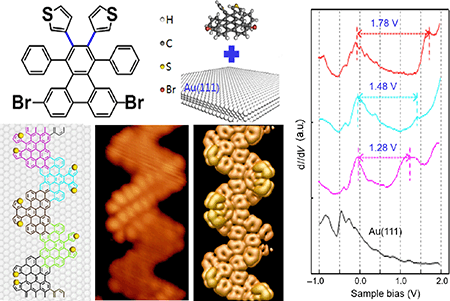Nano Research ( IF 9.5 ) Pub Date : 2017-07-06 , DOI: 10.1007/s12274-017-1550-2 Yan-Fang Zhang , Yi Zhang , Geng Li , Jianchen Lu , Yande Que , Hui Chen , Reinhard Berger , Xinliang Feng , Klaus Müllen , Xiao Lin , Yu-Yang Zhang , Shixuan Du , Sokrates T. Pantelides , Hong-Jun Gao
Unlike graphene sheets, graphene nanoribbons (GNRs) can exhibit semiconducting band gap characteristics that can be tuned by controlling impurity doping and the GNR widths and edge structures. However, achieving such control is a major challenge in the fabrication of GNRs. Chevron-type GNRs were recently synthesized via surface-assisted polymerization of pristine or N-substituted oligophenylene monomers. In principle, GNR heterojunctions can be fabricated by mixing two different monomers. In this paper, we report the fabrication and characterization of chevron-type GNRs using sulfur-substituted oligophenylene monomers to produce GNRs and related heterostructures for the first time. First-principles calculations show that the GNR gaps can be tailored by applying different sulfur configurations from cyclodehydrogenated isomers via debromination and intramolecular cyclodehydrogenation. This feature should enable a new approach for the creation of multiple GNR heterojunctions by engineering their sulfur configurations. These predictions have been confirmed via scanning tunneling microscopy and scanning tunneling spectroscopy. For example, we have found that the S-containing GNRs contain segments with distinct band gaps, i.e., a sequence of multiple heterojunctions that results in a sequence of quantum dots. This unusual intraribbon heterojunction sequence may be useful in nanoscale optoelectronic applications that use quantum dots.

中文翻译:

硫掺杂的石墨烯纳米带,具有一系列明显的带隙
与石墨烯片不同,石墨烯纳米带(GNR)可以表现出半导体带隙特性,可以通过控制杂质掺杂以及GNR宽度和边缘结构来对其进行调节。但是,实现这种控制是制造GNR的主要挑战。最近,通过原始或N-取代的低聚亚苯基单体的表面辅助聚合合成了V形的GNR。原则上,可以通过混合两种不同的单体来制造GNR异质结。在本文中,我们首次报道了使用硫取代的低聚亚苯基单体制备V形人字形GNR的方法,并首次制备了相关的异质结构。第一性原理计算表明,可以通过脱溴和分子内环脱氢作用,从环脱氢异构体中应用不同的硫构型,从而定制GNR缺口。此功能应为通过工程化其硫构型来创建多个GNR异质结提供一种新方法。这些预测已通过扫描隧道显微镜和扫描隧道光谱法得到证实。例如,我们发现含S的GNR包含具有不同带隙的片段,即,多个异质结的序列导致一系列量子点。这种不寻常的带内异质结序列可能在使用量子点的纳米级光电应用中有用。此功能应为通过工程化其硫构型来创建多个GNR异质结提供一种新方法。这些预测已通过扫描隧道显微镜和扫描隧道光谱法得到证实。例如,我们发现含S的GNR包含具有不同带隙的片段,即,多个异质结的序列导致一系列量子点。这种不寻常的带内异质结序列可能在使用量子点的纳米级光电应用中有用。此功能应为通过工程化其硫构型来创建多个GNR异质结提供一种新方法。这些预测已通过扫描隧道显微镜和扫描隧道光谱法得到证实。例如,我们发现含S的GNR包含具有不同带隙的段,即,多个异质结的序列导致一系列量子点。这种不寻常的带内异质结序列可能在使用量子点的纳米级光电应用中有用。多个异质结的序列,产生一系列量子点。这种不寻常的带内异质结序列可能在使用量子点的纳米级光电应用中有用。多个异质结的序列,产生一系列量子点。这种不寻常的带内异质结序列可能在使用量子点的纳米级光电应用中有用。












































 京公网安备 11010802027423号
京公网安备 11010802027423号